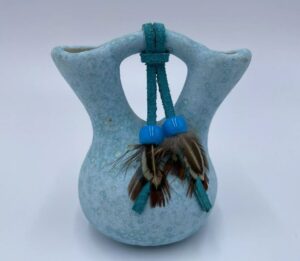The creation of a wedding vase is a spiritual process, usually undertaken by a skilled artisan of the tribe. The crafting begins with the gathering of clay, which is often sourced from sacred lands known to the community. The clay is cleaned, treated, and then shaped by hand or with the use of simple tools. The two-spouted design is not just functional; it is a representation of the life paths of the individual bride and groom, which, though they start as separate, will merge into one through marriage.

The design elements and decorations added to the vase are rich with cultural symbolism. These might include depictions of nature, such as the earth, sky, or water, which are significant in many Native American cultures for their life-giving properties. Other common symbols might include animals, which represent various virtues or tribal totems. The decorations are not only artistic expressions but also imbue the vase with blessings and prayers for the couple’s future.

This ritual is not just about the act of drinking but is a profound demonstration of balance and support, foundational qualities in any marriage. The ceremony and the vase itself teach the couple—and remind the community—about the importance of cooperation and mutual support. Today, while modern influences continue to blend with traditional practices, the use of the wedding vase in ceremonies remains a powerful link to the past, often serving as a poignant reminder of a couple’s roots and cultural identity.
